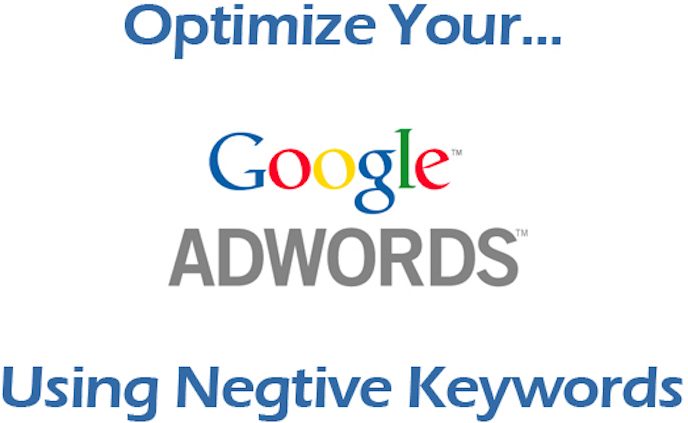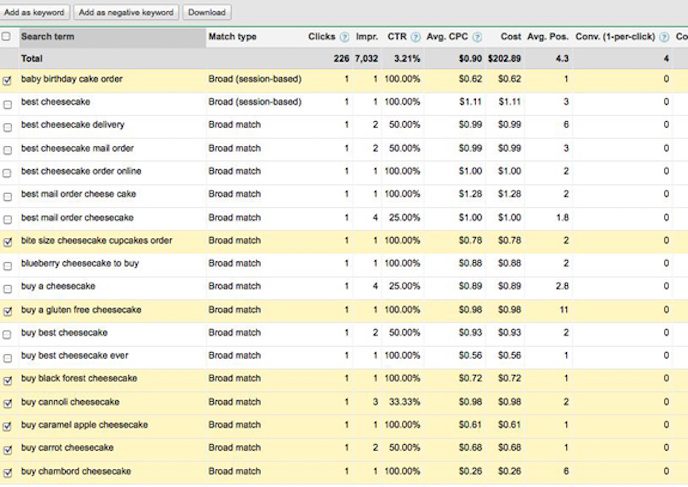In the first lesson, we explained how broad-matched keywords have an impact on the quality of clicks and the overall CTR. With broad-matched, you are letting Google AdWords automatically choose what’s right for your campaign, which doesn’t mean it’s perfect for you. Many people will argue a perfect AdWords campaign is very difficult to achieve. However, you can definitely come close using Negative Keywords. Just so you understand the next concept in more detail, let’s explore these two examples…
First, with broad-matched, you setup your target keyword and let Google combine relevant keywords together. The Google AdWords system decides what’s best for your campaign through data gathered from previous campaigns. However, if you are promoting a targeted niche, then broad relevant keywords will not help your campaign. Your CTR suffers and the overall quality of your campaign is low. This could mean paying higher per keyword compared to your competitor. With this type of setup, you’ll need a higher marketing budget to keep the campaign running throughout the month.
Next,
You have EXACT matched keywords, where you’ll specify what keywords you want your campaign displayed. However, if you are in a niche with very little competition, your campaign might not be displayed at all. Google AdWords uses a system that gathers data on the best performing keywords and displays ads relevant to those words. Using this system, Google can maximize their earnings by only displaying ads that have a CTR and people pay per click. By focusing on EXACT match keywords, you are protecting yourself from paying for irrelevant keywords, but have minimized the time your ad will be displayed. Quality keywords receive the most display time and have the highest quality score so using keywords that have no performance data means lower display time.
At this point, I know you’re thinking, how can you maximize your Google AdWords campaign for CTR and relevancy? I would like to introduce the concept of negative keywords…

What are Negative Keywords?
Here is a definition of negative keywords as per Google…
Negative keywords are an important part of every campaign because they help make sure that your ads appear only to people looking for what you offer. This added level of control can help you increase your click through rate (CTR), reduce your average cost-per-click (CPC), and increase your ROI.
Negative keywords, when combined with broad-matched keywords, can be very powerful. You will have to tweak the strategy a few times, however, once you find the right combination, you can attract relevant visitors to your website while keeping your quality score high. Your CTR will improve, increasing the chances of turning a profit from your AdWords campaign.
Finding Negative Keywords…
In both Google Analytics and the AdWords interface, you’ll be able to find the data you need. Even though AdWords does provide the information, they won’t implement negative keywords within your strategy because it’s your job to tweak your campaign. In Analytics and AdWords, you have a tab keywords, where you’ll be able to find the information you need to submit into your campaign as negative keywords.
For example,
Both analytical tools only provide you with the keyword people matched on, not what they typed in. In AdWords, you’ll see a list of keywords that displayed your ad and, next to it, if you received a click-through. The same applies to Google Analytics as it will only show you the keyword displayed and if it converted into a click-through. The bad news is both don’t tell you the keyword they searched, but only the keyword someone matched on. So, what now?
It’s your job to optimize your campaign by going through the list of keywords and select the ones that are not relevant to your campaign. If you’ve setup your campaign on broad-match, and it’s been running for a few weeks, you’ll have enough data to start eliminating the keywords that are completely irrelevant to your product or service. For example,
Here’s data from a Cheesecake AdWords Campaign.

You’ll find a handful of keywords that perform well and could result in a conversion. However, you’ll find some within this broad-match data that are irrelevant. Once you’ve removed negative keywords, your campaign, even though running as broad-matched, will not be displayed for those keywords. It’s a great way to keep your campaign CTR and quality score higher. With an optimized campaign, you’ll increase performance and lower the amount you pay per click.
